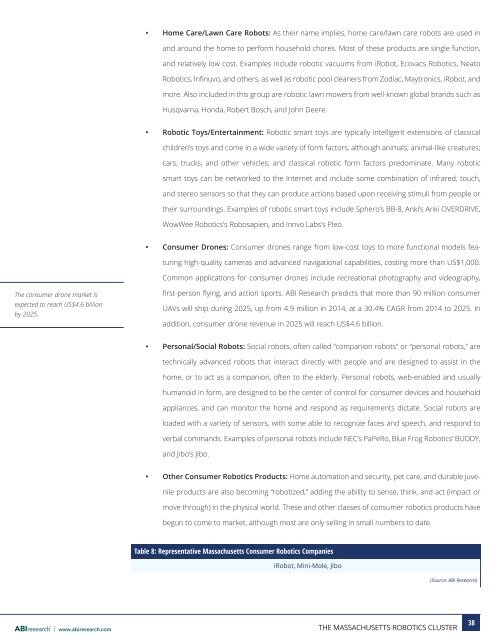ROBOTICS CLUSTER
Massachusetts%20Robotics%20Cluster%20Report%20Final
Massachusetts%20Robotics%20Cluster%20Report%20Final
Create successful ePaper yourself
Turn your PDF publications into a flip-book with our unique Google optimized e-Paper software.
• Home Care/Lawn Care Robots: As their name implies, home care/lawn care robots are used in<br />
and around the home to perform household chores. Most of these products are single function,<br />
and relatively low cost. Examples include robotic vacuums from iRobot, Ecovacs Robotics, Neato<br />
Robotics, Infinuvo, and others, as well as robotic pool cleaners from Zodiac, Maytronics, iRobot, and<br />
more. Also included in this group are robotic lawn mowers from well-known global brands such as<br />
Husqvarna, Honda, Robert Bosch, and John Deere.<br />
• Robotic Toys/Entertainment: Robotic smart toys are typically intelligent extensions of classical<br />
children’s toys and come in a wide variety of form factors, although animals; animal-like creatures;<br />
cars, trucks, and other vehicles; and classical robotic form factors predominate. Many robotic<br />
smart toys can be networked to the Internet and include some combination of infrared, touch,<br />
and stereo sensors so that they can produce actions based upon receiving stimuli from people or<br />
their surroundings. Examples of robotic smart toys include Sphero’s BB-8, Anki’s Anki OVERDRIVE,<br />
WowWee Robotics’s Robosapien, and Innvo Labs’s Pleo.<br />
• Consumer Drones: Consumer drones range from low-cost toys to more functional models featuring<br />
high-quality cameras and advanced navigational capabilities, costing more than US$1,000.<br />
Common applications for consumer drones include recreational photography and videography,<br />
The consumer drone market is<br />
expected to reach US$4.6 billion<br />
by 2025.<br />
first-person flying, and action sports. ABI Research predicts that more than 90 million consumer<br />
UAVs will ship during 2025, up from 4.9 million in 2014, at a 30.4% CAGR from 2014 to 2025. In<br />
addition, consumer drone revenue in 2025 will reach US$4.6 billion.<br />
• Personal/Social Robots: Social robots, often called “companion robots” or “personal robots,” are<br />
technically advanced robots that interact directly with people and are designed to assist in the<br />
home, or to act as a companion, often to the elderly. Personal robots, web-enabled and usually<br />
humanoid in form, are designed to be the center of control for consumer devices and household<br />
appliances, and can monitor the home and respond as requirements dictate. Social robots are<br />
loaded with a variety of sensors, with some able to recognize faces and speech, and respond to<br />
verbal commands. Examples of personal robots include NEC’s PaPeRo, Blue Frog Robotics’ BUDDY,<br />
and Jibo’s Jibo.<br />
• Other Consumer Robotics Products: Home automation and security, pet care, and durable juvenile<br />
products are also becoming “robotized,” adding the ability to sense, think, and act (impact or<br />
move through) in the physical world. These and other classes of consumer robotics products have<br />
begun to come to market, although most are only selling in small numbers to date.<br />
Table 8: Representative Massachusetts Consumer Robotics Companies<br />
iRobot, Mini-Mole, Jibo<br />
(Source: ABI Research)<br />
www.abiresearch.com<br />
THE MASSACHUSETTS <strong>ROBOTICS</strong> <strong>CLUSTER</strong><br />
38


